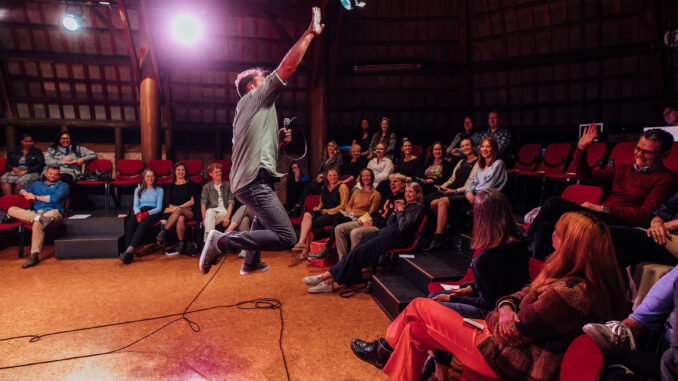
[Out of the Box and Into the Box: Aotearoa Theatre Enduring a Pandemic, and Dreaming of the Future]
Suddenly the opening exchange of Anton Chekhov’s 1895 play The Seagull made sense like never before:
“Why do you always wear black?”
“I’m in mourning for my life”
There on my laptop was Masha (Bronwyn Ensor), rocking the no-longer-care lockdown look. What else is Masha’s statement but a rationale response to the disruption of a global pandemic? Mourning for plans never fulfilled. Mourning for the diminution of our social experience, confined to select bubbles. Trying to replicate our need for contact through Zoom, and coming away restless, empty. I felt you Masha.
I’d tried to write something in early June about the experience of Aotearoa’s performing arts sector under lockdown. I felt the weight of making an offering to the historic record of what had – and hadn’t – occurred over the past months, but I could only make it a few words each attempt. With the country moving down the pandemic alert levels, I struggled to articulate recent events. They were too close, too raw, too overwhelming – and the immediate future still too uncertain.
And on a personal level, I was exhausted and down, still in Masha mode. Productivity be damned.
Really, I was missing the theatre. Maybe not so much the plays themselves – I could read and watch these in various forms at home if I wanted. I was missing everything around the theatrical event – the buzz, that special quality of communitas, sharing with others the ritual and spiritual dimensions of live performance. It was only in live theatre’s complete withdrawal that I could appreciate just how vital theatre had become to supporting my personal wellbeing: a space to socialise, connect, fulfill the primal need to feel part of a group. Theatre can be a superspreader of emotional contagion. Audience researcher Caroline Heim has found that audiences “catch or are infected by the contagion of laughter, crying and even applause”, helping to form community.
But when we needed to safeguard our community against another kind of contagion, our theatres went dark. Aotearoa locked down in a collective effort against Covid-19.
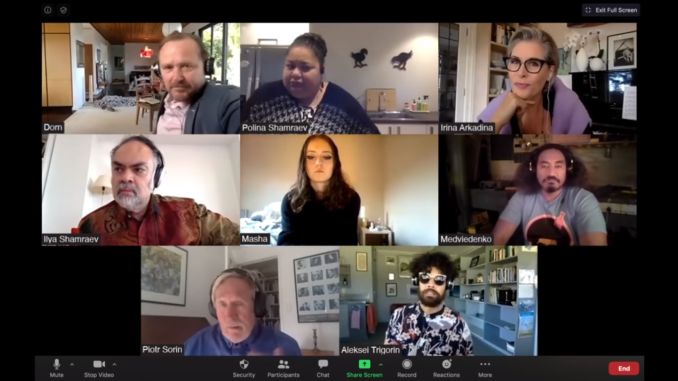
One immediate innovation was the embrace with a vengeance of the digital space. The Seagull is an exemplary example. Director Eleanor Bishop had been interested in Chekhov’s play for a while, but this version was created with the kind of swift-footed turnaround that would confound Chekhov’s lethargic characters. With co-writer Eli Kent, the digital adaptation was pitched to Auckland Theatre Company, who rapidly agreed. A dream cast was assembled, and over four Friday night instalments in May, we watched the characters play out their neuroses as they come together on Zoom over varying alert levels.
The Seagull was one out-of-the-box initiative to continue theatrical practice during a pandemic: out of the black box theatre and into the box of our screens.
On a larger level, the year’s pause in live performance presented an opportunity for further out-of-the-box thinking as we continued to reassess how we do things. Collectively, we want the struggles of 2020 to result in something positive. There is a desire to ‘build back better’, Covid-19 having exposed the existing flaws, vulnerabilities and inequities in our overlapping health, economic and social fabrics. For the performing arts, Covid-19 offers an unexpected invitation to fundamentally reconceive our processes and priorities. An initial list of spotlighted issues includes artistic sustainability (financially, mentally, environmentally and socially); accessibility for audience (cost, access, ableism); intersectional inclusivity, autonomy and safety; suitability of funding and infrastructure models; and crucially for Aotearoa, ensuring we have an enduring, meaningful and central commitment to Te Titiri O Waitangi across all areas of the performing arts. What will we do with this moment?
In writing this annual Theatrical Year in Review for Theatre Scenes as December comes to a close, I feel better able to give an account of this unusual and exceptional year in Aotearoa’s theatre. There’s a bit more distance and clarity now, and in the second half of the year I was reinvigorated by a number of special live performance experiences. Notwithstanding the remaining potential for further shocks from what former Butterfly Creek Theatre Troupe member and 2020 breakout star Dr Ashley Bloomfield terms a “tricky virus”, our performing arts sector is holding its breath and confidently offering a new summer and beyond of live programming in 2021.
Has mourning given way to hope?
LAST SUMMER
I find it now a difficult imaginative task to flashback to the beginning of 2020 and the performance summer before Covid. In Te-Whanganui-a-Tara, Circa Theatre hosted Dave Armstrong’s less-than-agenda setting political comedy The Surprise Party. In Ōtautahi, Court Theatre went for Tennessee Williams’ New Orleans set classic A Streetcar Named Desire.
Kicking off with OurGala, Auckland Pride was the event of February in Tāmaki Makaurau, with Festival director Max Tweedie offering a renewed grassroots emphasis on queer inclusivity. Our reviewers attended Leather Lungs: Yas Queen!, Transhumance, Night of the Queer, and Aroha Awarau’s poignant Provocation, “an elegiac tribute to the victims of horrendous acts of violence.”
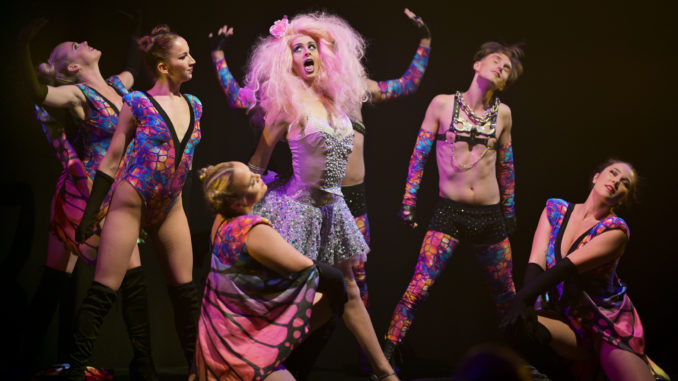
Nathan Joe reflected that this year’s Pride was one of the proudest and most vibrant he had ever seen it, and was perhaps the proudest he had felt towards it personally:
Inclusivity and diversity are often bandied about as an act of tokenisation but it felt earned and deservedly won here. A refreshing change from the recent controversies that have plagued Auckland Pride over the last few years. While New Zealand still has a long way to go in terms of producing queer Kiwi theatre on its mainstages, this Pride shows promise in laying the foundations for our contemporary voices.
The Auckland Fringe was forging its own sense of renewed purpose under the leadership of Borni Te Rongopai Tukiwaho. The Fringe was the place to take the pulse of Auckland’s performing arts scene: who’s playing with form, who’s asking the big questions?
Described as a dance theatre ‘artivism’, This Fragile Planet (a dream collaboration between New Zealand Dance Company and The Conch) put the relationship between human and environmental degradation at the centre of the work. Rather than being left with a feeling of doom, the work gave reviewer Cynthia Lam a feeling of “wonder and warmth where humanity and nature exist as one, with the potential for redemption.” Gary Stalker’s Ghost Trees similarly pondered our relationship with the natural world, in an intensely personal and moving account linking the scourge of Kauri dieback disease with his late wife’s experience with Cancer. Best Theatre winner Alone by Luke Thornborough told a sci-fi tale of a two-women space crew on a mission hoping to offer a solution to an earth ravaged by climate change.
Nathan Joe observed a strong current of shows at the Fringe that put the “white male gaze (and voice)… under scrutiny.” Gemishka Chetty and Aiwa Pooamorn’s Have You Ever Been With An Asian Womxn? involved, as Jess Macdonald wrote, “a humorous yet raw exploration of as four unapologetic Asian women reclaim their sexual identities and move out from behind the search terms.” Satirising the Love Island trash-tv hookup genre, Lust Island, performed by a formidable all-women improv lineup “was even more captivating as car-crash, cringe-worthy humour than the original TV.” Faceless Hair Cry by Sofia McIntyre and I Know What I’m Doing by Melody Rachel in their own original and experimental ways asked audiences to be conscious of how we were responding to the performers.
Michael Hurst’s return season of No Holds Bard sat awkwardly against this lineup, lacking an interrogation into the racist history of white actors representing Othello. The Works of William Shakespeare by Chicks offered welcome Shakespeare subversion, although Erin O’Flaherty found the abridged version of Leah Pellinkhof’s 2006 play “just not quite current enough to hit its mark in this climate of post #metoo frustration – including frustration that we’re still having to hassle our professional theatre companies to program female-driven/female-written work.”
Proudly Asian Theatre’s Deep, a Pākehā male creatively driven work (co-produced with SICKO productions) was “an unusual programming misstep” for PAT. Nathan Joe reported that “despite beautiful puppets, the exploration of marine archaeology and female sexuality wasn’t always clear” and Rand Hazou wondered if “this is territory that a female playwright would be better placed to shed light on and navigate?”
Basement Theatre offered a provocation for artists to explore durational works. The resulting five shows in the Basement Theatre Season of Duration was one of the Fringiest (and most rewarding) places to be.
Grace Hood-Edwards stayed for the full four hours of Alice Kirker’s Jelly Baby, which, among other events, featured the systematic destruction of Sally Rooney’s novel Normal People with its scraps shoved into a jar of jelly. The show was a “unique privilege” for Hood-Edwards to witness: “Alice Kirker has an undeniable magnetic energy that sustains the “daunting” four hours […] whilst Jelly Baby’s cheeky smile is utterly charming and utterly forgivable.”
For the Auckland Arts Festival, Silo offered a new season of Upu, which Jess Macdonald found to be “a deeply impactful collection of poetry which, despite varying in theme and tone, is united by Oceanic bonds – by ‘Moana, which must unite for people, land and oceans to thrive.’”
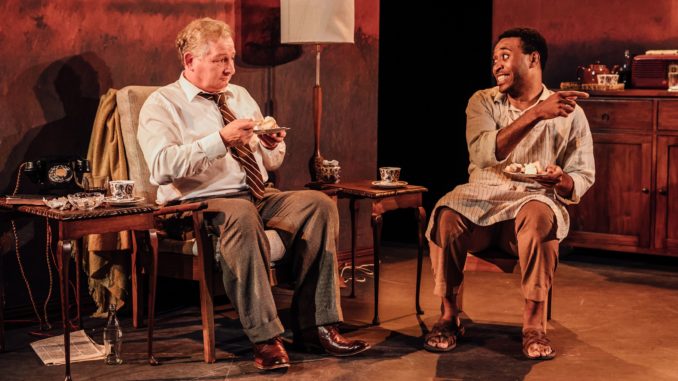
Auckland Theatre Company presented Black Lover by Stanley Makuwe, described by Anuja Mitra as “an illuminating glimpse into an overlooked chapter of history […] which saw the Invercargill-born Todd become Prime Minister of Rhodesia and advocate for equality between Zimbabweans and white settlers.”
Touring to the Sydney Festival, the Auckland Arts Festival and the New Zealand Festival, Black Ties by John Harvey and Tainui Tukiwaho was a significant collaboration between ILBIJERRI Theatre Company and Te Rēhia Theatre Company. Black Ties offered a complex dialogue between two First Nations cultures about the scars of colonisation, with an inherent tension in how this played between indigenous and white audiences. Reviewing the Sydney production, Emele Ugavule felt it missed the mark in its treatment of the play’s womxn, and Jess Macdonald found that a slanging match between characters veered “unapologetically through offensive terms which strike different chords with audience members – some reel with laughter, others remark that lines have been crossed.”
Beyond the Festivals, 2019 Auckland Theatre Awards winner Odd Daphne by Joshua Iosefo played a return season at Māngere Arts Centre with a powerful message around mental wellbeing and community support. Maulik Thakkar called it “a crucial watch for Pasifika young people looking for representation of their own lives in the world of art. It is Auckland’s shame that more shows with near-complete Person-of-Colour casts and crews do not feature in more theatres across the city, rendering almost half of our population invisible to the privileged who attend theatre regularly.”
Tuatara Collective’s Little Black Bitch by Jason Te Mete was also engaged in the potential of theatre for healing and wellbeing, offering, as Nathan Joe put it, “a potent reminder that the tools we have to heal each other have been passed down for generations on this land, and require rediscovery rather than invention.”
In its final ever Auckland show, the Pop-up Globe seemed to be atoning for past missteps with its New Zealand premiere production of Emilia by Morgan Lloyd Malcolm and directed by Miriama McDowell, which centred the story of poet Emilia Bassano (speculated to be the ‘Dark Lady’ of Shakespeare’s sonnets) with a majority POC female cast.
In March, The Basement offered seasons of Year of the Tiger (虎- Hǔ) by Alice Canton (a kind of improvised doco-theatre featuring six strangers who share the same Zodiac animal) and Essays in Love by Eli Kent and Oliver Driver, adapted for the stage from Alain de Botton’s eponymous novel, which Rachel Berryman found to be “a nuanced, humorous and overwhelmingly relatable reflection on the ways we understand, rationalise and reconcile heartbreak.”
And finally, on The Civic stage an Australian touring production of Broadway Musical The Book of Mormon opened, which Sharu Delilkan and Tim Booth described as “totally unmissable.”
That’s a huge amount of vital theatrical activity, confidence and momentum in the opening months of the year.
A CHANGE IN THE AIR
That summer I performed a show at both the Auckland Fringe and Wellington’s NZ Fringe. Theatre was everywhere. Looking back, I feel I was hopelessly naïve to the impending threat of the virus and what was to come. We had no contingencies, no discussion of a pandemic plan – it just wasn’t on the radar. In our show’s Wellington season in early March the first ripple of change was when I went to greet an audience member, and they opted for an elbow bump and a foot tap over a handshake.
Over the next two weeks as an audience member soaking up all that Wellington’s theatre had to offer, Covid consciousness grew at a rapid rate. As I wrote for the Playmarket Annual, shows began to look very different with a Covid lens:
There’s this moment in NZ Festival’s MÁM (Michael Keegan-Dolan): a performer bestows a kiss on the lips of another in the company, who accepts it with rapture. The kiss than cascades around the ensemble, blissfully transforming each receiver. There’s an innocence in the freewheeling sexuality, a shared intimacy, a sublime liberation.
Within a week, my recollection of this image turned it into something terrible, foolish, dangerous, as we began to question the safety of festival-going and close contact. On the Saturday, I smugly watched work-in-progress The Brief and Frightening Reign of Phil, the new musical from Bret McKenzie and the UK’s National Theatre about the George Saunders character whose brain literally falls off whenever he goes off on a narrow-minded rant and is elevated to leader. How relevant to the current political climate! How great to be able to claim that when this becomes a big West End and Broadway hit, we saw it here first!
On the Sunday [15th March] – the festival’s final day – all tickets were cancelled. I didn’t get to see Strasbourg 1518, but I imagine that its investigation of a mysterious dancing plague would not have played as mere historical footnote. Our theatre had received its first unwanted kiss with a modern pandemic.
GOING DARK
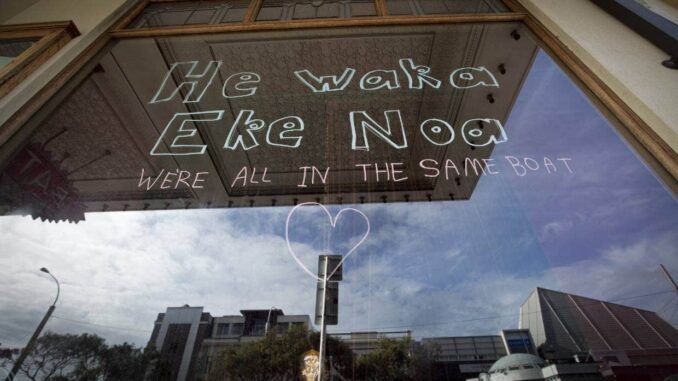
The word Jacinda used was decimated. Covid-19 had decimated Aotearoa’s arts sector. For an art form whose fundamental reason for being is to bring people together, the performing arts had been one of the earliest hit by Covid-19 – one of the first to close, one of the last to reopen.
As the incoming public health challenge became more and more apparent as our long March dragged on, cancelled events began to pile up. Fueled by fear and adrenalin, I wrote about what was happening the week before lockdown, the post immediately rendered out of date as cancelled events and Covid events kept coming.
This period exposed issues with liabilities, especially for our independent artists: if they wanted to cancel their event for the safety of themselves and their audiences, they would have to wear the cost. In Wellington, BATS theatre showed leadership by closing, a signal to the rest of the NZ Fringe. Bigger shows closed when restrictions were announced by the Government on 19 March that no more than 100 people could gather indoors together at a time.
For those pushing on with performance, the decision was made for them when the level 4 lockdown was announced on 23 March. The lockdown went into effect on 25 March. Out of the black box, boxed into our homes.
It would be a period of almost three months without any in-person performances.
And so, into mourning. Mourning for what could have been, for all those lost experiences. The Comedy Festival. The Dunedin Fringe. Those productions you were really looking forward to seeing (I still hope to see a Shane Bosher directed production of Hedwig and the Angry Inch in my lifetime). International tours. Community productions. School productions. All that work. Gutting.
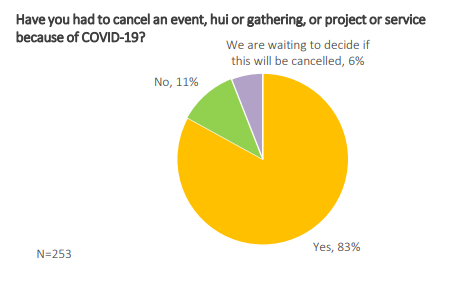
Creative Sector in Tamaki Makaurau, Report for Te Taumata Toi-a-Iwi
An April survey of Tāmaki Makaurau’s creative sector by Te Taumata Toi-a-Iwi (formerly Arts Regional Trust) found 83% of the 332 respondents had to cancel an event, hui or gathering or project or service because of Covid-19. Individuals reported financial losses as high as $200,000. Creative organisations reported losses ranging from less than $1000 to as high as $900,000. The report stated “people who work in the creative sector are often working on limited term contracts, and can be reliant on commissions and revenue from public access or performances to sustain a living. The COVID-19 environment has at least temporarily brought a halt to these and many other ways of simply making a living.”
The Pantograph Punch gathered some personal responses by theatre artists facing cancelled work due to Covid, incuding the NZ star of Melbourne’s Harry Potter play. Hannah Smith of internationally touring company Trick of the Light captured the anxiety felt by many artists entering lockdown:
The kind of work we do, we cannot work from home – it requires being in a room with other live humans. Theatre is contact. Theatre is community. We don’t know what theatre is in a time of social distancing and self-isolation.
With usual practice disrupted, artists were asking themselves: what do we do now?
UNBOXING
Internationally, there was a tidal wave of archived recorded theatre and new digital theatre released online. Shakespeare was everywhere: from the London Globe theatre productions to The Tempest on Zoom. National Theatre of Great Britain put up the NT Live productions that had previously found their way to New Zealand as niche arthouse cinema screenings. Andrew Lloyd Webber also put his shows online, in case you wanted to scratch your 1998-recording-of-Cats itch. And then there was the 2016 original cast recording of Broadway’s Hamilton, originally planned for cinema release in 2021, offered on Disney Plus as the only place to see the show while the mega-hit’s productions were shuttered worldwide. On the one hand, democratising access to a show infamous for exorbitant ticket prices, on the other, an attention economy blitzkrieg in the corporate streaming wars. Hamilton’s a Disney prince now.
Theatre from all around the world – in your living room. This should have been the dream, but I felt listless. I watched some offerings. Richard Nelson’s playwriting instincts satisfied me in the Aristotelian Zoom play What Do We Need to Talk About?, and Take Me to the World, the starry tribute to Stephen Sondheim for his 90th birthday showcased both the (technical) agony and ecstasy of live streaming.
But mostly, I found it all a bit of a slog. It’s difficult for recorded and digital theatre to compete with the polish of Netflix’s library. I didn’t finish the National Theatre’s Frankenstein. But then again, nor did I begin Tiger King.
Local theatremakers also explored the potentials and pitfalls of pivoting to digital. Could you do what you do, but do it online?
ATC’s The Seagull demonstrated what is possible with artistic innovation and resources. The series gained attention in UK media and the first episode has had over 11,000 views on YouTube (a physical production would need a sell-out three week season at ATC’s ASB Waterfront Theatre to reach those numbers).
Nathan Joe considered how the team made a virtue out of the obstruction of the Zoom medium:
What might otherwise be a gimmick has us see it as a complete reflection of its form and structure. Whereas on stage, we are concerned with everything we see on stage, Zoom forces the audience and the makers to focus on everything we see on screen.
The unique filmic convention of the close-up is used to repeated effect here. It’s a tool that can generate intimacy between performer and audience that the stage cannot. This is doubled several times over by having multiple screens at once, different characters inhabiting the zoom medium for intimate two-hander scenes to raucous ensemble pieces.
By the same token, empty spaces, cameras pointed towards spaces without bodies becomes disarming. Gazes left unreturned, gazes averted, actors staring down the barrel of the camera.
[…] The inherent awkwardness of communication over zoom – with its delays and pauses – sentences delivered simultaneously to everyone connected and to no one at all – makes Chekhov’s own portrayal of failed communication more palpable than ever.
ATC followed up with a filmed version of Ibsen’s The Master Builder directed by Colin McColl, in lieu of the originally programmed live production. This one felt like it lost more than it gained in its transfer to screen. With or without a pandemic, ATC are committing to offering one digital production each year, a welcome move to allow more people to gain access to ATC’s work (especially for secondary school drama students nationwide).
In Wellington, BATS had made an early decision to pursue livestreaming as a way of continuing to offer performance during a pandemic. After closing its doors, on March 20th, thanks to the technical support of Tane Hipango, Brynne Tasker-Poland and Benny Jenning, BATS offered $15 tickets to a livestream of George Fowler as Hugo Grrrl’s empowering trans narrative Princess Boy Wonder, which played to an online audience far greater than the capacity of the venue’s random stage.
Another cancelled NZ Fringe and Dunedin Fringe show, Butcher Holler Here We Come by USA company Ad Hoc Economy was able to be experienced as a ‘theatre on demand’ show. The company used their time at BATS to film scenes from the show, which were spliced with scenes recorded by individual actors in quarantine in the USA.
Filmed theatre did not strike reviewer Tim George as the most engrossing way to take in live drama, but he was won over by the show:
When the company’s song midway through is cut off by an ugly edit, or when sound dips out, or a shot has poor resolution, these moments feel like potholes, constantly drawing attention to the experience of watching this on a screen. But rather than take me out of the experience, it became the experience – watching a group of creative people pull this show together despite the odds.
Zoom experiments followed. Binge Culture got their banana suits out of their closests for a live digital version of their cult improvised durational show Break-Up [We Need to Talk]. Watching the slow meltdown of a relationship over Zoom proved the perfect format to reflect the strangeness and anxieties of our new lockdown bubble life. Feast with Fools was a rambling character-clown show, but I appreciated being able to spend time with some favourite local performers. There were Zoom improv shows from Doom & Bloom, The Corona Diaries from Jean Sergent, and BATS hosted an open Zoom ‘happy hour’ every Friday.
After the country moved to Alert Level 2 on 13 May, BATS could again offer livestreaming of performances inside the theatre. Irene Corbett reviewed the stream of Jean Sergent’s Change Your Own Life:
Change Your Own Life successfully transitions to the streaming medium. A rich sense of atmosphere is achieved through the superb quality of the audio. Sergent appears to be wearing a microphone pack which transmits her voice with total clarity, no sensation of movement or muffling. There is also clear audio of the space, the almost imperceptible hum of theatre lights, laughter from the small live audience, and incredibly, dead silence when Sergent commands her in persons audience’s fullest attention. The sensation of baited-breath came through the computer, I did not think this was possible. It was shockingly engaging and you very much feel the presence of the in-person audience. While still a very individual theatre experience, the stream possesses a warmth and an intimacy I had not expected.
Like BATS, Little Andromeda in Christchurch also hosted streamed and digital performances, including an online version of Dungeons & Comedians.
Trick of the Light’s Hannah Smith explored her question of what theatre is in a time of self-isolation through the Zoom horror-comedy It’s Behind You. This was commissioned by Circa Theatre, who also partnered with Te Rēhia Theatre Company with bilingual ‘love at first zoom’ play Found in Translation.
Led by Paola Rotondo, Theatre Live Online was another initiative conceived in lockdown to keep going and keep connected with audiences. Christchurch’s Two Productions, Auckland’s Nightsong and Wellington’s A Slightly Isolated Dog were challenged to create a new work for live and online audiences. Performed in September when theatres had reopened, Nightsong’s Call it a Night by Carl Bland was a moving abstracted meditation on the relationship between audiences and performers, Jennifer Ludlam asking an in person and virtual audience “shall we start again, you and I?”
Tempo went digital for an extended online dance festival from May to December, with new works appearing regularly in two online ‘venues’. Te Pou theatre produced an expansive digital edition of its Kōanga development festival, featuring podcasts, playreadings and performances.
Nathan Joe argued now was the time for an audio drama revival. RNZ’s major plays collection was available for listening over the lockdown. Red Scare adapted the podcast investigation genre for its genuinely unsettling drama Apocalypse Songs. The Pantograph Punch’s Artist in Residence gave us 15-minute personalised audio performances from artists including choreographer Sarah Foster-Sproull, poet and movement artist Jahra Wassala and theatremaker’s Nisha Madhan and Jo Randerson.
Silo Theatre responded to lockdown with an Instagram Residency, with a daily artist takeover of Silo’s Instagram Live “to teach, dance, garden, vogue, draw and more through your screens.”
Other projects added to digital archives. Proudly Asian Theatre’s Fresh Developments project allowed us to follow the journeys of Natasha Lay, John Rata, Nathan Joe and Chye-Ling Huang as they developed work with the company. Ngā Whakaaro Huritāo is an incredible contribution to the history of Tawata Productions, featuring two ‘seasons’ of accounts from directors, actors, production managers, designers, festival directors who have worked with Tawata Productions over the past 15 years. The Pantograph Punch’s Pacific Arts Legacy Project includes must read reflections from artists includig Tusiata Avia, Nathaniel Lees, Mīria George, and Tanya Muagututiʻa.
While for some theatremaker’s the pivot to digital was a hurried affair with varying levels of quality and success, the truism was we collectively turned to art during the lockdown, and these digital efforts provided comfort, entertainment and distraction over this period and beyond – from Chris Parker and Thomas Sainsbury (my Mum’s favourite) on Instagram, to Jack Buchanan and family’s viral Lockdown Boogie (3 million views and counting). A special shoutout for the good timing of Snort: Live appearing on TVNZ on Demand. If I couldn’t get to The Basement in person, seeing the recordings of these improvisers working a Basement crowd was the next best thing.
Basement Theatre took a different approach than BATS and Little Andromeda, resisting the rush to go live online. The home of Tāmaki Makaurau’s independent performance scene ended up shutting for 6 months, offering artist residencies when in person work could resume. Basement programmer Nisha Madhan explained the venue’s thinking in a post entitled Live (Why I’m Not in a Hurry), available as audio and text.
My first instinct, like many, was to encourage them (and as a practising artist, me) to throw everything they (I) had online. Live stream, YouTube, Instagram it, start a Basement TikTok account (still a great idea tbh), set up a Zoom party – whatever it was, I needed to get it up as soon as possible and stay relevant. Theatre could not and would not just lie down and take this burn to its pride and fundamental makeup of being – a form that relies on human beings together in proximity. The artform was hemorrhaging and needed a bandaid.
I didn’t do any of those things. I completely failed to instantly provide a digital lifeline for artists. I found myself leaning away from the digital space as a bandaid. I leaned away because, as a third of the world found itself in lockdown, the internet felt like a problematic place to be. As the whole world suddenly plugged in and started posting their beautifully appropriated lock down yoga practices online through the homogenous frames of Instagram live, TikTok, and Facebook – the internet suddenly felt very crowded.
[…] Global pandemic or not, the power structures that fail humans and artists on the regular in the physical world still exist in the digital space.
Madhan made a necessary case for pausing as an artistic response to the pandemic, rather than continuing to operate in the digital space under these same destructive power structures. It was not the time to resume normal programming.
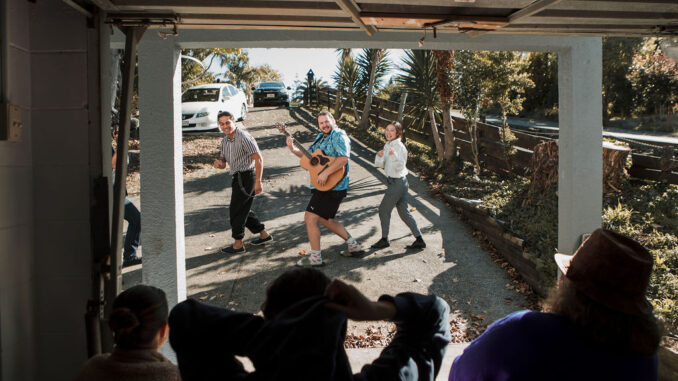
In true out-of-the-box style, Te Pou theatre also offered a non-digital response to theatre in a time of social distancing with its Front Yard Festival of contact-less short performances toured under alert level 3 to driveways, front lawns and grass verges of vulnerable whānau members, kaumātua and kuia. The Festival offered aroha through live performance in a time of need, and went on to tour front yards in Palmerston North and New Plymouth.
A special performance was given to Rose Greaves in Ponsonby, who had been attacked in a letter for speaking Te Reo. Greaves told Stuff that it was “a lovely gesture of them to get in contact with me… I feel quite privileged and it’s wonderful because I really love live theatre.”
SECTOR SURVIVAL
While creatives attempted to adjust to lockdown, bubbles, and Zoom, the great unknown was whether there would be an industry to return to whenever this thing came to and end. Would we still have the artists, venues, technicians?
To awkwardly adopt economic speak, theatre and the performing arts are a vital part of Aotearoa’s wider creative ecology and industry, which the Government acknowledges as contributing “nearly $11 billion a year to GDP, employs 90,000 people and supports the wellbeing of communities.” (By way of comparison, Agriculture contributes $12 billion a year to GDP).
In April it was forecasted that the cultural sector would be hit twice as hard as the rest of the economy and approximately 11,000 jobs would be on the line without Government intervention.
Auckland’s Q Theatre was in jeopardy early on, losing 85% of its income due to event cancellations. Kiwibank NZer of the Year Jennifer Ward-Lealand fronted a heroic campaign to “Help Q Get Through” and Q successfully fundraised $150,000. Q Theatre hosted a smattering of events at the end of 2020 (including an election clash between the PM and Opposition Leader), but did not completely resume this year. Without the lifeline of being a CNZ funded or Council controlled venue, Q theatre was particularly exposed to the pandemic shock, and are one of many venues that remain vulnerable.
As live performance became untenable, hopes were directed towards the response by Government and its funding agency Creative New Zealand to support the survival of the sector. In March I wrote:
CNZ’s response to the Covid-19 pandemic will be the greatest test the organisation has faced in the 25 years since its formation (its regional response following the Christchurch Earthquakes provides some models). For a body that has historically been perceived as not going out of its way to save companies in financial trouble […], the financial backing it can muster is going to be decisive.
CNZ recently adopted the strategic goal that “New Zealand’s arts sector is resilient.” Now is the time to back this to the hilt. The entire theatre and arts ecology is at risk.
I am relieved now to be able to write that CNZ came through. Big time. On 14 April, 20 days after New Zealand entered lockdown, CNZ announced a $16 million sugar hit as part of its Emergency Response Package that was anticipated would cover the sector through to June 30 (the end of the financial year). Redeploying existing funding streams and drawing on reserves, the package had two main strands. Investment clients who received recurrent CNZ funding could apply for “short term relief” to help them stabilise their business and remain viable. Non-investment clients (everybody else) could apply for resilience grants to “help them recover, maintain and develop their practice in a completely changed environment.” These took the form of Arts Continuity grants for short term projects that could be delivered under changing alert level conditions, and an emergency relief grant that could provide a top-up to arts practitioners receiving the Government’s wage subsidy as part of CNZ’s commitment to paying practitioners fairly.
During the next 7 weeks, CNZ received 4,539 applications for the Emergency Relief and Arts Continuity grants – triple the applications CNZ usually receives annually across all its grant programmes. In recognition of the unprecedented demand, CNZ freed up further funding to bring its total Phase 1 investment to $29 million. Overall, CNZ invested $76.5 million in the arts sector for the 2019/20 financial year, a whopping 60% increase on the previous year.
It also cannot be overstated how decisive the Government’s broad-based wage subsidy policy was for supporting the arts sector. The wage subsidy supported 130+ jobs across Auckland Theatre Company and Q Theatre alone, with organisations like Court Theatre, Silo, Te Pou and BATS also accessing the subsidy. Particularly crucial was the Government ensuring that non-salaried independent contractors were also eligible for the subsidy. Trick of the Light’s Ralph McCubbin Howell told the Playmarket Annual that “the wage subsidy is straight up one of the most consistent pay cheques I’ve ever received, and certainly relieved some of the stress in the short term when all our work disappeared.”
While live performance remained shut down, over those middle months of the year we got a glimpse of what we could achieve as a country if our artists had generous access to funding. The cumulative success rate of the Arts Continuity Grants – supporting theatre, dance, literature, music, visual arts, community arts projects and more – was 45%. Of the 637 grants made, 90 (14%) were for theatre projects.
This was a significant turn around for funding statistics from CNZ. As Kate Prior highlighted for The Pantograph Punch, “there’s a term, ‘unfunded excellence’ that gets used at CNZ to describe those excellent applications which simply couldn’t make the cut in such a competitive environment. In 2020, all the excellence was funded […] Amongst all the hard stuff, let’s never forget those crazy days when the Arts Grants gates came down and the artists made a solid run for it.”
Then the trolls arrived in the form of the Taxpayer’s Union, who saw CNZ’s emergency grants as low hanging fruit to pelt the Government with for perceived profligate spending. Bearing the CNZ logo and a red ‘approved’ stamp, the Taxpayer’s Union spotlighting of individual funded projects looked like they could have come from CNZ themselves. Indeed, the Union arguably did a better job than CNZ itself of publicising funding for projects worth celebrating. The Union’s attack (joined by the New Conservative’s Deputy Leader) on Circa’s children’s show The Glitter Garden by George Fowler and Lori Leigh resulted in an upsurge of ticket sales and a number of Twitter users opting for the ‘pay it forward’ ticket option so more young people could attend the show.
It was a meanspirited campaign from the Taxpayer’s Union (still continuing in December), who themselves drew down $60,436.80 from the Government’s wage subsidy scheme (no doubt helping to support the Union’s debt monster election performance art). Perhaps they were hoping for a revival of the attacks the right had deployed in the 2000s against Helen Clark and Labour’s “chardonnay socialism” and perceived wasteful spending of such things as hip-hop tours. That the Taxpayer’s Union appear to very much be the outliers on this issue suggests that there is a much greater acceptance of the need to provide state funding for the arts sector, especially when dealing with a pandemic.
It must also be noted that the Taxpayer’s Union were mispresenting where the money from CNZ’s emergency response actually came from. The real scandal is that CNZ’s funding has relied on the whims of the country’s lotto buyers (15% of lotteries profits goes to CNZ). If we are to uncouple the link between arts (and sports) funding with problem gambling, we need direct taxpayer investment in CNZ.
The Union’s misdirected trolling also ignores legitimate critiques of our funding models. In RNZ’s investigation on the role of CNZ, author and theatremaker Eamonn Mara argues that there is a danger that funding “ends up going to people who are really good at filling out forms.” Despite what the Taxpayer’s Union would have people believe, funding is not handed out willy nilly by lofty decision makers at CNZ head office: there is a rigorous peer review process and independent applicants spend hours of unpaid labour putting together their submissions.
Racism in funding could also be called out. Tainui Tukiwaho criticises a funding field in which kaupapa Māori theatre does not get “as much money as Pākeha companies who have less responsibility than we do.” Black Creative Aotearoa’s Dione Joseph finds it “heartbreaking that when diversity funding became available that people of Black, Caribbean, African, Middle Eastern and Latin descent were not invited to the table – let alone participate.”
Let us also not forget those who fell outside this year’s emergency package from CNZ. Aotearoa joined the global #WeMakeEvents campaign to bring visibility to the “hidden events workforce” crucial to smooth running of the performance industry.
A forced but positive effect of the pandemic was for the arts sector to come together as a sector like never before. Historically limited by competition for scare resources and siloed thinking, organisations and individuals shared resources, knowledge and advocacy. The PANNZ online hui series in partnership with Auckland Live was an essential meeting point for navigating the challenges of the pandemic, and helped to make CNZ’s opportunities and processes accessible for the sector. Mark Amery and his team gathered arts news week by week and kept us updated through The Big Idea Lowdown. The G8, a collective of Māori performing arts organisations, are providing support through Ngā Hua Toi, including ongoing resources, feedback and pānui for Māori theatre and dance artists. Tānemahuta Gray and Meg Williams organised a campaign seeking to increase Government funding for Creative New Zealand.
There was considerable disappointment when there was little for the arts announced in the Government’s 2020 budget on 14 May. But finally, on 25 May, Jacinda Ardern went to Te Papa and announced an injection of $25 million for CNZ over two years as part of a $95 million funding announcement for the arts. A few days later, there was a further $175 million recovery package via the Ministry of Arts, Culture and Heritage.
The Prime Minister, and Arts Minister stated:
Now more than ever we need a thriving arts and cultural sector. We saw in the aftermath of the Canterbury earthquakes the potential of creativity and culture to create jobs, drive economic recovery and enhance social wellbeing, and they can help us do it again.
The Government’s Cultural Recovery package represented the biggest government investment in the arts for two decades.
Under lockdown, an incredible mobilisation and advocacy effort had seen the sector through the initial danger period.
LIVE AGAIN
Every day on the radio there seemed to be a new representative from a different industry arguing that we needed to lift restrictions to get the economy back on track. I never heard anyone from the arts loudly clamoring for us to reopen. Audiences would need to feel safe returning to see a live show.
On June 8th, with no more active cases of Covid-19 in Aotearoa, the country entered alert level 1. Theatre, in theory, could resume.
The industry proceeded with caution. One, getting a production mounted took time. Two, not knowing if the Covid-free situation would hold, this would involve a great deal of risk.
The first live productions reviewed by the comprehensive Theatreview website in alert level 1 were George Fenn’s Bon Jovi riff WANTED. Blaze of Glory at Wellington’s Circus Bar venue and Sorry for Your Loss by Cian Gardner at Hamilton’s Meteor Theatre, which both opened on 19 June.
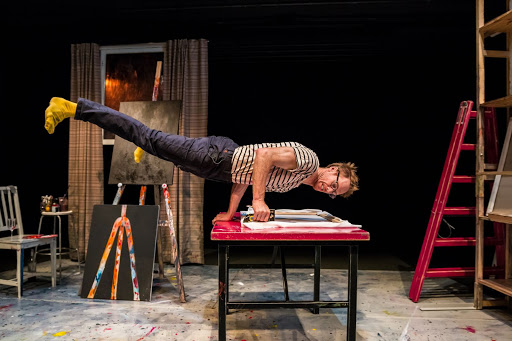
The first in person live performance I got to see was the postponed season of Thomas Monckton’s The Artist, which performed at Circa Theatre from 24 to 27 June. I wrote about the experience for the Playmarket Annual:
On my night a child responded with vocal delight at each of Monckton’s physical tricks, becoming a special running gag of its own. I felt like I too was seeing this show through the eyes of a child, full of the wonder of livenes. Oh yeah, this is what I have missed, this is what only live theatre can do. And how remarkable, that in that month of June, Pōneke was one of the few places in the world where you could safely experience this.
Encouraged by BATS and Circa Theatre, Wellington went forward reasonably confidently in offering live performances. Toi Whakaari’s third year actors performed two plays at BATS representing the recent lockdown experience. While Pre Lockdown Post devised with Hone Kouka did little more than step us through life under changing alert levels, Victor Rodger’s Lockdown La Ronde (inspired by the 1879 German ‘daisy-chain’ style play) was a decidedly horny affair using lockdown as a background for a series of in person and virtual encounters between a cavalcade of yearning, desperate characters. This was the Covid content I wanted!
This season took place with reduced capacity at BATS due to the country’s move into Level 2 on 12 August. Auckland had gone up a step further to Level 3, meaning life performance was once again a no go in the country’s largest city. It was devastating timing for Basement Theatre, who were due to reopen that week.
Te Taumata Toi-a-Iwi repeated its survey of Tāmaki creatives following the Auckland lockdown. This time 58% of respondents indicated they had to cancel an event, hui or gathering, or project or service, and a further 36% had had to postpone. The report noted:
Even with the shorter and less intensive lockdown from August, many were still impacted by COVID, and many are still struggling with the impacts of the earlier lockdown. Income sources and opportunities remain disrupted and cancellations/postponements are an ever-present factor. There does not seem to be the same level of long-term cancellations in this survey compared to the April survey, but this may indicate that fewer are planning long-term in the current environment. A common theme in September 2020 was the inability to plan far ahead, and alongside this, adapting to a new environment, recognising that COVID will not be dispelled in the near future, and embedding these new ways of working into development and delivery of work going forward. Responses suggest that people are more confident of getting by financially than in April. However, many are reporting financial losses, and in this survey, one in four respondents are unsure about being able to get by and face an uncertain future.
The survey also found that “the impacts or uncertainty of the COVID-19 environment, appears to be more strongly evident among Māori and Moana Oceania respondents.”
Auckland Theatre Company returned to the stage in September with its Back on the Boards season, featuring return seasons of Still Life With Chickens by D.F. Mamea and Black Lover by Stanley Makuwe (its original season having been cut short by the pandemic). Taking its cue from Palmerston North’s Regent Theatre season of Sister Act, which had converted its theatre into five separate quadrants to comply with the limits on gatherings of 100+, ATC had similarly reconfigured the Waterfront Theatre to safely increase its total capacity and overcome the no more than 100 people rule.
ATC also produced a new work responding to the pandemic, 48 Nights on Hope Street, written by Freya Daly Sadgrove, Leki Jackson-Bourke, Nathan Joe, Ana Scotney, and Cian Elyse White and inspired by Giovanni Boccaccio’s Decameron. Irene Corbett couldn’t help but comment on the intentional similarities: “Set during the Black Death epidemic, the Decameron is a story cycle about a group of young people who trade stories to pass the time as they wait out the plague – an oddly familiar set of circumstances which are driven home by the strict and responsible measures of the ASB Theatre staff who require signing in before entry and offer masks to all.”
The Basement Theatre finally reopened on 22 September with Before Karma Gets Us by Tess Sullivan, Ariaana Osborne and Liv Parker as part of the Basement Reunited programme, which also featured Mistress Moe Laga’s Neon Bootleg, Tūrongo Collective’s Nohopuku and Bubbah’s My Ode to South Auckland. Making a statement were two works tackling the climate crisis: Heatwave by Grace Augustine and Our Modern Earth (Is A F*cking Mess) by Amber Liberté.
Basement Theatre’s 2020 Company in Residence Tuatara Collective made their own offering to the emerging ‘Covid play’ canon with Fresh Choice. Sharu Delilkan and Tim Booth observed:
The trials and tribulations of working in a local supermarket provides a wonderful foil for the creeping and ominous onset of the Covid-19 crisis, but the real beauty of this piece is that it’s not woeful, miserable or tragic – it’s more akin to a group therapy session in the Basement Theatre. At its heart Fresh Choice is a strangely and hilariously happy show full of life, love, and stupidly humdrum mediocrity. And the fact that the fabulous four actors almost didn’t get the chance to graduate, due to the cancellation of the MIT’s Creative Arts programme, makes their fantastic performances even more poignant.
Closing The Basement’s truncated year, Le Basement XXXmas Cabaret involved a rather on the nose plot point that “Le Basement Cabaret will be forced to close its doors if Alex and Zsa Zsa cannot fundraise 100,000 dollars to save their venue.”
At TAPAC, Prayas celebrated the significant milestone of its 15th anniversary with Yātrā. Continuing the story of Kutisar from Guru of Chai, Indian Ink Theatre Company debuted their latest work, Paradise or the Impermanence of Ice Cream. Jess Macdonald described her experience of returning to the theatre:
As audience members pack the rows of the TAPAC theatre, I take my seat beside a group of strangers for the first time in months. There’s an edginess to the atmosphere – a flurry of discussions around the recent Covid cases in managed isolation – and I flinch as the woman next to me coughs into her arm.
This is theatre in late 2020. I brace myself.
Then, we are plummeted into darkness: a richly savoured moment as I sink into the throng of electricity, unique to the anticipation of live performance. It’s a feeling I, like many others, have sorely missed.
Silo Theatre was able to continue with one show from its disrupted 2020 season: Every Brilliant Thing. Written by Duncan Macmillan and Jonny Donahoe, on paper it did not seem the most vital choice for Silo to pursue – the UK touring production had previously played as part of the Auckland Arts Festival. But with Zoom direction by Danielle Cormack and alternating performances from Jason Te Kare and Anapela Polata’ivao, the play’s participatory exploration of mental health turned out to be the perfect show for Aucklanders coming back together in the theatre. Jennifer Cheuk loved
[the] overarching intention for Every Brilliant Thing to simply bring people together – to create a connection between strangers. The set-up of the audience seated around the stage means we are always looking at each other. This intimacy not only reminds us that we are all human, but also that we are never truly alone. The stage and audience set-up really created a sense of community and emphasised how important it is to connect with others, particularly during Covid-19.
The Modern Māori Quartet’s Garage Party also proved an ideal show to see out the difficult year at The Civic’s Wintergarden, a show The Spinoff’s Sam Brooks described as the “best justification for not taking live performance for granted.”
The Royal New Zealand Ballet (who received a direct Government funding boost of $2 million) were finally able to shake off their forced 2020 slumber with a national tour of The Sleeping Beauty in October.
The debut of the Whangarei Fringe (co-founded by Hayley Clark, Laurel Devenie and Georgia-May Russ) was something to celebrate in 2020 with 8200 people attending 90 events across 17 days in October . Te Tairāwhiti Arts Festival marked its second year, establishing itself as one of the country’s most exciting Festivals.
Looking at what’s happening around the world, what we have managed to get to the stage this year is remarkable. Aotearoa’s relatively successful elimination strategy has allowed us to be in a position to stage far more theatre than has been possible in most other parts of the world.
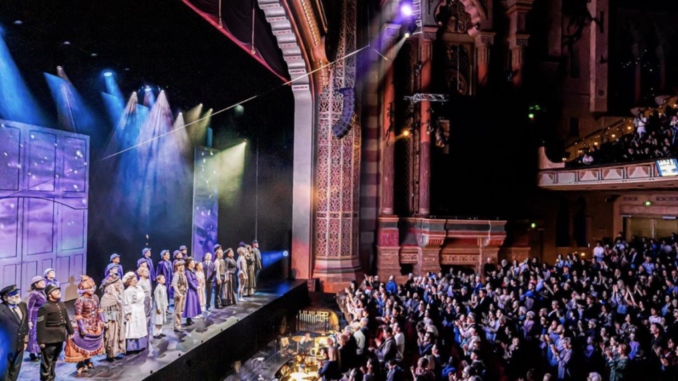
At The Civic, the long delayed amateur production of Mary Poppins was able to claim on its October opening night that it was the biggest stage show playing at that time in the world. Sharu Delilkan and Tim Booth said it was “the perfect ‘Jolly Holiday’ to escape the trials and tribulations of 2020.”
In Wellington, Circa Theatre’s pantomime Cinderella sold out the month of December. In Christchurch, Court Theatre’s production of Jersey Boys has been extended until the end of January due to popular demand.
NYC’s Broadway went dark in March, and at this stage is due to remain shut until May 30, 2021. Despite being a considerable cultural and economic engine, the UK’s theatre industry has been battered by the pandemic and a lethargic political response. Ticket sales at UK theatres fell by 93% in 2020. In May, producers were warning that “British theatre is on the brink of total collapse.” Theatres were closed on March 16, with limited openings in July, but closed again in November. London theatres had been encouraged to reopen in December, but were blindsided by the order to shut again from 16 December. There are warnings that UK theatres could lose more than a quarter of permanent jobs. The situation is dire.
Australian performing arts had been described as facing a “doomsday moment” as Covid-19 and funding cuts (including to tertiary drama programmes) threatened pathways to the stage. In April, I Lost My Gig recorded $340 million in losses across the country’s live entertainment industry (The Impossible Project website records some of the events “made impossible in 2020.”) The Federal Government was slow to prepare a rescue package for the Arts, only announcing in June a $250 million package – and it’s been slow to hand out this funding. Arts organisations have been described as being locked in an “arts hunger games” to receive funding. While many theatres reopened from September, the necessity of Melbourne having to enter a long lockdown was a substantial setback.
For theatre success stories, we look to countries that have also had relatively successful approaches to containing the virus. Some theatres in South Korea were able to stay open when Aotearoa’s were closed, with audiences receiving thermal body temperature checks, free disposable masks and hand sanitiser upon entry. During this time South Korea was the only place in the world where Andrew Lloyd Webber’s ubiquitous The Phantom of the Opera was still playing.
Taiwan’s theatre has followed a similar trajectory to ours. The Taiwan Traditional Theatre Festival was suspended in March, but like New Zealand, mass gathering restrictions were lifted in early June and live performance subsequently resumed.
CHANGE, NOW
We do not yet have a full picture of the effect of Covid-19 on Aotearoa’s theatre sector in 2020. We know it to be substantial.
Playmarket offers an initial data set. From July to June 2018/2019 the agency issued 52 professional performance licenses for New Zealand plays. In the same period 2019/2020 it issued 33, a drop of 36%. Community performance licenses went from 96 to 72, a drop of 25% (school/tertiary performance licenses increased slightly from 114 to 116, reflecting a healthy demand from the education sector). A running tally of Wellington professional and co-op productions has 151 shows taking place in 2019 compared to 117 in 2020 (a drop of 22%). It would be interesting to run these numbers in other centres.
The international examples of the UK, USA and Australia offer a stunning counterfactual for what our performing arts might now be facing if Covid had continued to spread in the community, or if we didn’t have speedy access to wage subsidies and arts relief packages. There’s been a devastating amount of work that hasn’t been able to happen this year, but there’s also a great deal that has been achieved.
But we are not out of danger yet, and for the performing arts to sustainably thrive, there’s an awful lot that we need to do.
While initial financial support has seen off major redundancies and organisational collapse in the creative sector over this year, a recent briefing to new Arts Minister Carmel Sepuloni has warned that the worst of the job losses were yet to come without further Government support. “While some activities have resumed, financial viability remains a concern for many organisations in the sector. The creative workforce continues to face significant job insecurity and risk.”
Remember that extra $25 million in direct funding for Creative New Zealand over two years? CNZ are putting the full amount towards a 12-month programme of investment till June 2021. While the floodgates were opened in the first phase of emergency relief funding ($29 million over 2+ months), this pool has to last a bit longer. In the current Arts Grants rounds, we are back to a trickle of successfully funded projects. Over the four rounds so far, there’s a cumulative success rate of 24% (compared to the 45% of the Arts Continuity Grants). Of the 167 projects funded so far, only 8 have been directed towards theatre projects (4.8%).
Having supported the development of a number of worthy independent projects in the first half of the year, we now face the prospect of a miniscule number of projects being supported to actually reach an audience next year.
And after June 2021, then what? Adding to the uncertainty is the emptying of Council coffers across the country, and their ability to support the arts in local communities.
A big unknown is how many will be supported through the implementation of the Ministry of Arts, Culture and Heritage’s additional $175 funding package. This breaks down into $7.9 million for Careers Support for Creative Jobseekers – a reincarnation of the former PACE programme – which the Government expect will help up to 2000 people over four years. $70 million over three years goes to the Creative Arts Recovery and Employment Fund “to support the rebuild of the creative industries by commissioning and supporting creative projects at a national and local level.” $60 million for a Cultural Innovation Fund “to support new ways of operating, cross-sector partnerships, and create new ways to add value to the economy, particularly through digital exports” (digital exports!!). $20 million for a Cultural Capability Fund “to focus on immediate needs in response to COVID-19, such as legal services, online delivery and audience development”, and finally $16.5 million specifically for a New Zealand Music Recovery Fund.
There has been disquiet from the industry that these funds are being administered by the Ministry itself, which lacks existing funding processes and infrastructure. In late October the Government was implored to “hand out $150m Covid fund now or lose the arts sector.”
The Cultural Capability Fund opened in December, eligible for applications from ‘cultural sector leadership organisations’. The Creative Arts Recovery and Employment Fund opens early next year, and there is no start date yet for the Cultural Innovation fund. In a marked contrast to CNZ’s above and beyond comms this year, communication about the scope and priorities of these funds has been downright shoddy. Currently it is difficult to understand the justification for keeping these funds with the Ministry over the option of further increasing Creative New Zealand’s budget. As Christchurch Symphony Orchestra chief executive Gretchen La Roche expressed, “Creative New Zealand understands the arts and cultural sector probably the best of any institution in the country. They have the structure and the expertise.”
What is missing is an overall strategy. At a livestreamed election arts debate, it became clear Labour’s Arts policy was these emergency packages. Te Taumata Toi-a-Iwi sees the need for a national ngā toi strategy. They warn that
the one-off nature of recovery funding means there is potential for this funding to create and support the sector for only three years. Parachuting additional short to medium-term funding into the sector, particularly to under-represented communities, without a vision and a plan for sector sustainability beyond those three years could cause more damage than good. Funding needs to be managed within the context of a vision, strategy and investment plan designed to ensure the sector’s long-term sustainability. Long-term needs, such as sustainable capability and infrastructure development and evaluation across the ecosystem, should be incorporated into thinking about what we fund now.
The University of Canterbury’s Paul Millar also called for a longer-term arts vision from our politicians:
What if kapa haka groups, theatre companies, comedians, musicians, and dancers were funded to travel to every town and city in New Zealand, and take the best of our creative arts to the regions? What if, as our borders slowly open, we market high-end art tours through the nation, stopping at galleries and craft workshops big and small, with artist talks along the way?
I feel confident that with visionary investment our artists and creative industries can play a leading role in hastening our recovery, economically, socially and culturally. But for that support to be meaningful, I think it needs to build upon the just-announced funding to help the arts “get back on their feet”.
A cause for concern is the sector’s ability to manage further risk and overcome further cancellations should there be a need to cancel events again into 2021. Writing for The Guardian, Australian Arts Manager Zohar Spatz states that “the arts sector needs big ideas and out-of-the-box thinking. But we’re not going to find the space for creation, imagination and innovation while we’re exhausted, depleted and operating in survival mode” – a sentiment readily applicable to the New Zealand context. One of Te Taumata Toi-a-Iwi’s very good ideas is a system for underwriting productions to manage the risk of producing live performance whilst the possibility of community transfer remains a live threat.
In what could be a time for bold choices and new ideas, we can see a conservatism creeping in to the programming announcements of our major companies. New New Zealand work is in the minority in 2021 for Auckland Theatre Company and The Court. More promising is the Auckland Arts Festival 2021 Aroha programme. Going local was a necessity for the Festival while our borders remain largely closed, but there’s a potent sense of place and purpose in the lineup. New Artistic Director Shona McCullagh called for open proposals to the Festival and reported receiving 250 proposals, 173 of which were theatre projects. Our theatremakers are out there, bursting with ideas.
Writing speculatively for Exeunt Magazine, Allice Saville posed the question “what if theatre makes this a time for fringe to the front? Experimentation first?”
Next year both Auckland and Wellington’s Fringe Festivals are set to have their biggest Festivals ever, despite the effective halt of the international touring circuit. I was astounded when I first learnt this, but it’s something I take a huge amount of comfort in. While there’s a degree of throwing Covid-caution to the wind, it speaks to the incredible desire of our artists to make work and connect with audiences.
This, still, after the existential threat posed by the pandemic in 2020. Theatre practitioners could add a further existential crisis around what theatre meant in the digital space (“it’s not a play, it’s a digital event” to quote the Zoom Seagull), adding to the already tenuous categorisation of ‘theatre’: is the term still useful to us in these content consuming times?
In an article for The Incercept, Naomi Klein writes of Covid ushering the “warp speed acceleration” of our homes into entertainment centres. When “everything is home delivered”, we will have the need for “far less live art.” Is this where we are going? What will that mean for the future of the form?
Certainly recorded and digital theatre holds the potential to remove barriers for theatre experiences that may otherwise have been inaccessible. Eleanor Bishop sees a place for digital theatre “that wishes to directly and critically engage with the digital space in which we now spend much of our lives.” She told the Playmarket Annual she’s “interested to see where the form goes after Covid – when the form isn’t directly responding to the pandemic, but more to digital space in general?” The questions for theatremaker’s become ‘what is your stage?’ and ‘how and who are you engaging?’. Regardless, the pause in usual practice encourages renewed reflection on the core purpose of performance, and what needs it needs to serve – and if the liveness is crucial, why it is crucial.
This reflection also needs to involve constant critical unpacking around what ideologies and power structures performance might be propping up.
Coming out of the renewed Black Lives Matter protests this year was the ‘Dear White American Theater’ letter and petition, issued by a collective of Black, Indigenous and People of Colour theatremakers in the USA: “We see you. We have always seen you. We have watched you pretend not to see us.” 100,000+ people have signed the petition demanding change for BIPOC artists. “About theatres, executive leaders, critics, casting directors, agents, unions, com-mercial producers, universities and training programs. You are all a part of this house of cards built on white fragility and supremacy. And this is a house that will not stand. This ends TODAY.”
Theatre in Aotearoa New Zealand is built from a similar pack of cards. As Te Pou and Te Rēhia’s Amber Curreen expresses: “Ours is a systematically racist country and we are all forced to take part in telling the story of European eminence daily. This hurts us all, kills our teammates and urgently needs to change.”
Curreen’s was one of a range of perspectives shared in the Playmarket Annual responding to the provocation ‘what do we want our theatre to be?’
Taki Rua’s Tānemahuta Gray pondered, “How can we improve the sustainability of the artistic life to create a healthier journey that prioritises the hauora of all who drive this waka forward? How can we make sure that the mental, physical, emotional and spiritual wellbeing of the arts is transformed into a priority for a better work/life balance for all in the sector?”
BATS General Manager Jonathan Hendry recognised that “our audience capacity cannot support ticket sales as a way of making a living. By continuing our current model we are contributing to the devaluing of the art and artists.”
Basement programming manager Nisha Madhan echoed that “most artists just received a pay rise through the wage subsidy and their CNZ top up. The past was utterly unsustainable for artists, and Basement’s model was part of that.”
BATS are implementing longer seasons and exploring new models. Basement Theatre are looking to support mid-career artists through the new co-pro scheme (which, as Kate Prior pointed out, bears a similarity to Circa theatre’s long standing co-up model). Outgoing Basement Executive Director Elise Sterback told The Spinoff “we’ve made venue hire cheaper, but we haven’t made people’s careers more viable.” As The Basement continues to redefine itself under the incoming leadership of Cat Ruka and pursue sustainable futures, the next question will be what other spaces and models will also rise up to give all generations of artists their best possible shot to sustain a career in the creative sector.
***
I do feel hopeful.
Amazingly, at the end of 2020 Aotearoa’s theatremakers find themselves one of the best placed in the world to pursue their practice. The Western theatre centres that we have historically put on a pedestal have been paused. Now is the time to tell our stories, elevate our artists.
We have an opportunity to fundamentally reshape and embed how we value artists in Aotearoa.
The pandemic has shown us how ill-fit for purpose our existing systems of value have been. It has shown us who our essential workers really are: supermarket staff, doctors and nurses, teachers, elder carers, scientists, port workers….
As we continue to navigate the impact of the pandemic, we recognise our artists as essential workers (creators) too.
To help us reimagine and reconceive our potential as individuals and as a national community. To support our collective wellbeing. To bring us together to debate, connect, and share.
We have a big task ahead of us.
Time for action.
SEE ALSO:
– The Pantograph Punch: 2020 sucked but the art was beautiful
– The Big Idea: The Lowdown on 2020
Theatre Scenes Theatrical Year in Reviews: 2019 ; 2018 ; 2017 ; 2016 ; 2015 ; 2014 ; 2013 ; 2012 ; 2011 ; 2010

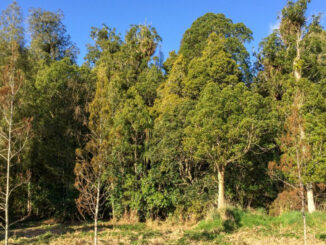
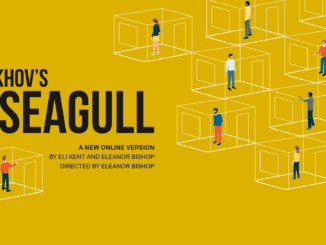
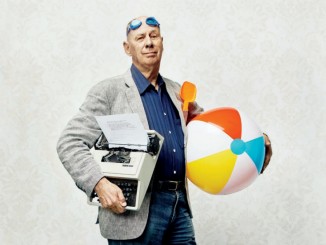
Leave a Reply